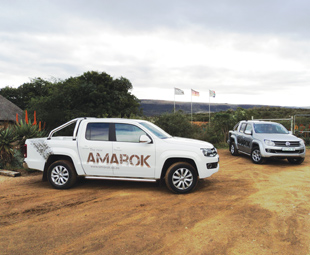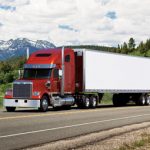Amarok in action

The Volkswagen Amarok is here. Well, almost. CHARLEEN CLARKE was one of the first South African journalists to drive it on South African roads.
The official launch of the Amarok, which takes place next month, must be the worst-kept secret around. Hell, we were writing about it two years ago. That was when Volkswagen first announced that it would launch the bakkie.
It was at the IAA Commercial Vehicle show, and the vehicle had pride of place on the company’s massive stand. We were also at the world launch that took place the night before the show opened – Bryan Ferry rocked us with his Roxy Music, as journalists from across the globe were treated to the first sighting of this enormous, important, as yet unnamed product within the Volkswagen range.
In 2009, the name was leaked to the media, and then subsequently formally announced. The bakkie would be Amarok, named after a wolf.
 Early in 2010, it was time for journalists to drive the first production units – over in Argentina where the bakkie is lovingly pieced together. Bearing in mind the significance of this new model, we decided to make it our cover star, and – in May 2010 – the Amarok graced our cover. At the time, we asked the question: could this be a Hilux-beater?
Early in 2010, it was time for journalists to drive the first production units – over in Argentina where the bakkie is lovingly pieced together. Bearing in mind the significance of this new model, we decided to make it our cover star, and – in May 2010 – the Amarok graced our cover. At the time, we asked the question: could this be a Hilux-beater?
This question was once again foremost in mind when we headed down to Port Elizabeth to drive the first South African production units. It’s a logical question – the Hilux has dominated the bakkie market for so long. In fact, it’s dominated the vehicle market – it was the single most popular vehicle in South Africa last year. I’m talking the entire market here – it even knocked the socks off entry-level cars which, in our cash-strapped economy, tend to rule the sales statistics roost.
But it’s also a tall ask; the Hilux may be a little long in the tooth but it’s an outstanding vehicle. Will the Amarok snap at its heels or remove huge dollops of its market share?
Well, let’s start with the first thing that one notices when reviewing any new vehicle: the exterior styling. The Amarok is definitely better than the Hilux in this regard. With its Volkswagen nose and softer lines, it’s way prettier. The interior styling of the Amarok is better too; it looks just like the interior of any Volkswagen car.
The seats are comfortable and they provide good support, while the quality of materials used is top-notch. There are some good practical features in the vehicle too; such as the power socket right on top of the console, where you can plug in your trusty GPS. That’s a really nice feature; I hate those untidy wires that hang from the windscreen down to the cigarette lighter.
But it’s far from faultless. The safety belt attachment point is untidy and rudimentary, there isn’t nearly enough storage space for your bits and pieces and there is a downright silly cup holder contraption on the floor just in front of the rear seats. It looks as though it’s an afterthought, it appears flimsy and it doesn’t look as though it will last very long. It’s a surprising feature in a Volkswagen.
 What isn’t surprising is the ride comfort. If I had to travel from Johannesburg to Cape Town in a double cab, I would want it to be in an Amarok; it’s extremely comfortable – up front and in the back. The ride is a little softer than other bakkies, but handling and road holding is never compromised. It soaks up any undulations in the road and you don’t have that bone jolting, filler dislodging drive that you get in virtually all other bakkies.
What isn’t surprising is the ride comfort. If I had to travel from Johannesburg to Cape Town in a double cab, I would want it to be in an Amarok; it’s extremely comfortable – up front and in the back. The ride is a little softer than other bakkies, but handling and road holding is never compromised. It soaks up any undulations in the road and you don’t have that bone jolting, filler dislodging drive that you get in virtually all other bakkies.
Yet another aspect of the Amarok that didn’t fail to surprise me is the safety; Volkswagen has long enjoyed a reputation for building über safe vehicles. The Amarok does a good job in this regard. ESP is standard on the Highline (it’s optional on other models) and off-road ABS is standard across the range. We saw a demonstration of this technology; it really does work well. Hill Start and Hill Descent Assist are included with ESP.
But, of course, the most controversial aspect of the new Amarok is the engine. It’s powered by a 2.0-litre motor (all the technical specs appear on the graph) and some customers are nervous that it may be too pap. Is this a justifiable concern? I honestly cannot comment. In Port Elizabeth, we had four adults in the vehicle and it never felt as though it was lacking in the power stakes. But, in fairness, the vehicle wasn’t loaded. Hopefully – when the official launch takes place next month – we will have an opportunity to verify its capabilities while operating under a full load. The load bay is the widest and deepest in its class; it’s also the longest amongst double cabs, so we know that the vehicle is more than capable of taking a huge load.
We also don’t know pricing yet. At this stage, we’re expecting the Amarok to be slightly more expensive than the equivalent Hilux models – expect to pay a premium of about R5 000 or so. All will be revealed at next month’s official launch and, of course, we will be there to bring FOCUS readers all the news.
Published by
Focus on Transport
focusmagsa



